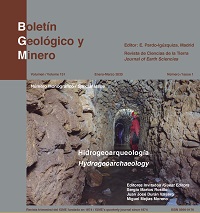Hydrogeological context and hydrogeoarchaeological heritage associated with the La Mota Fortress (Alcalá la Real, province of Jaén, southern Spain)
DOI:
https://doi.org/10.21701/bolgeomin.131.1.003Keywords:
urban water supply, water quality, hydraulic infrastructure, hydrogeological heritage, water resourcesAbstract
La Mota Fortress is a medieval military enclosure erected on the upper part of the homonymous hill, in Alcalá la Real (province of Jaén, southern Spain). Although previous vestiges have been found, the fortress reached its greatest splendour during the Nasrid-dynasty period (13th and 14th centuries). Its geographical location, in the limit between the old Christian and Muslim kingdoms, conferred a great strategic value to this military complex as a defensive bastion in the northern border of the ancient Kingdom of Granada. This fact caused the citadel to repeatedly be besieged and its inhabitants put into practice a particular system for water supply, based on the combined use of groundwater, stored in the calcareous sandstones of Tortonian age, and rainwater, collected in numerous cisterns sited within city walls. In this paper, the potential interest of this particular supply system is analyzed and discussed. To this end, we describe the hydrogeological functioning of the small aquifer on which the Nasrid fortress was built, and the system of underground wells and galleries that was hidden inside. In addition, the water resources and possible groundwater reserves are evaluated and their physico-chemical characteristics are detailed. Finally, the relevance in the water supply system of one of the most significant withdrawal facilities (Pozo de la Conquista) is analyzed, as well as the role played by the well in the conquest of the city by the Christian troops of Alfonso XI.
Downloads
References
Azañón, J. M., Roldán, F. J., and Rodríguez Fernández, J. 2012. Fallas y despegues extensionales en el Subbético Central: implicaciones en la evolución Neógena de las Zonas Externas de la Cordillera Bética. Geogaceta, 52, 13-16.
Calvo Aguilar, C. 2004. El abastecimiento de agua en la Fortaleza de La Mota de Alcalá la Real: Perspectiva arqueológica. In: Funciones de la red castral fronteriza: homenaje a Don Juan Torres Fontes. Alcalá la Real (Jaén). 69-80.
Calvo Aguilar, C. 2017. Las galerías subterráneas de la Fortaleza de La Mota. Ayuntamiento de Alcalá la Real (Jaén). Inédito. 10 pp.
Díaz de Neira, J.A., Enrile Albir, E., Hernaiz Huerta P.P. and López Olmedo, F. 1991. Mapa geológico de España. Serie Magna, 1:50.000, hoja nº 990 (Alcalá la Real). Instituto Tecnológico Geominero de España, Madrid. 54 pp. ISBN: 84-7840-112-1.
Gollonet, J., González-Ramón, A., Rubio-Campos, J.C., Rosales, M. and Hidalgo-Cano, J.L. 2002. Operaciones de recarga artificial en los acuíferos de Mancha Real-Pegalajar y de Alcalá la Real. Libro homenaje a Manuel del Valle Cardenete. Aportaciones al conocimiento de los acuíferos andaluces. IGME, CHG, Instituto del Agua de Andalucía (COPTJA) y DPG, Madrid, 177-181.
González-Ramón, A., Martín-Montañés, C., Gollonet, J., Martos-Rosillo, S. and Rubio-Campos, J. C. 2009. La recarga artificial como apoyo al abastecimiento de poblaciones. Experiencias en la provincia de Jaén. Boletín Geológico y Minero, 120(2), 289-304.
IGME 1998. Informe de los trabajos previos para la realización de una experiencia de recarga artificial en el acuífero de Los Llanos de Alcalá la Real (Jaén). Instituto Geológico y Minero de España. Informe interno. 87 pp.
Martín-Montañés, C., Rubio-Campos, J.C., Puche-Castilla J., Gay-Torres J.J. and Medina-Vernalte, A. 2018. Contribución al conocimiento hidrogeológico para una gestión sostenible del acuífero de las Calcarenitas de Alcalá la Real-Santa Ana. En: X Simposio del Agua en Andalucía. Unidos por el Agua. Tomo 2-3. (M. Olías, J.C. Cerón, J.J. Durán-Valsero, J.A. López-Geta, C. García de la Noceda, G. Ramos -Editores-), pp 995-1003. Publicaciones del Club del Agua Subterránea, 2-3. ISBN vol. 2: 978-84-09-05454-1. Depósito legal: M-32725-2018.
Martos-Rosillo, S., González-Ramón, A., Jiménez-Gavilán, P., Andreo, B., Durán, J.J. and Mancera, E. 2015. Review on groundwater recharge in carbonate aquifers from SW Mediterranean (Betic Cordillera, S Spain). Environmental Earth Sciences, 74(12), 7571-7581. https://doi.org/10.1007/s12665-015-4673-3
Martos-Rosillo, S., Morales, R. and Durán, J.J. 2018. El agua subterránea en la Historia. De cómo la Humanidad se ha abastecido mediante las aguas subterráneas desde el Paleolítico hasta la época de las catedrales Góticas. Colección Planeta Tierra. Ed: Instituto Geológico y Minero de España y los Libros de la Catarata. Madrid. 142 pp.
Mudarra, M., Andreo, B., Barberá, J.A. and Mudry, J. 2014. Hydrochemical dynamics of TOC and NO 3 Acontents as natural tracers of infiltration in karst aquifers. Environmental Earth Sciences, 71(2), 507-523. https://doi.org/10.1007/s12665-013-2593-7
Núñez, I., Araguás-Araguás, L., Moreno, L., Rubio, J.C., González-Ramón, A., Pérez-Zabaleta, E., Gollonet, J. 2006. Evolución hidrogeoquímica del acuífero carbonatado profundo de la Loma de Úbeda (Jaén). Boletin Geológico y Minero, 117, 613-616.
Rodríguez Fernández, J. 1982. El Mioceno del sector central de las Cordilleras Béticas. Tesis Doctoral, Universidad de Granada, Granada, 224 pp.
Roldán, F.J., Azañón, J.M. and Rodríguez-Fernández, J. 2012. Desplazamiento extensional del Subbético entre las sierras de Cabra y Alta Coloma (Valdepeñas de Jaén. Zonas Externas de la Cordillera Bética). VIII Congreso Geológico de España. Oviedo. GEOTEMAS, V-13: 484. Schoeller, H. 1962. Les eaux souterraines. Masson, París, 642 pp.
Downloads
Published
How to Cite
Issue
Section
License
Copyright (c) 2024 Consejo Superior de Investigaciones Científicas (CSIC)

This work is licensed under a Creative Commons Attribution 4.0 International License.
© CSIC. Manuscripts published in both the print and online versions of this journal are the property of the Consejo Superior de Investigaciones Científicas, and quoting this source is a requirement for any partial or full reproduction.
All contents of this electronic edition, except where otherwise noted, are distributed under a Creative Commons Attribution 4.0 International (CC BY 4.0) licence. You may read the basic information and the legal text of the licence. The indication of the CC BY 4.0 licence must be expressly stated in this way when necessary.
Self-archiving in repositories, personal webpages or similar, of any version other than the final version of the work produced by the publisher, is not allowed.















